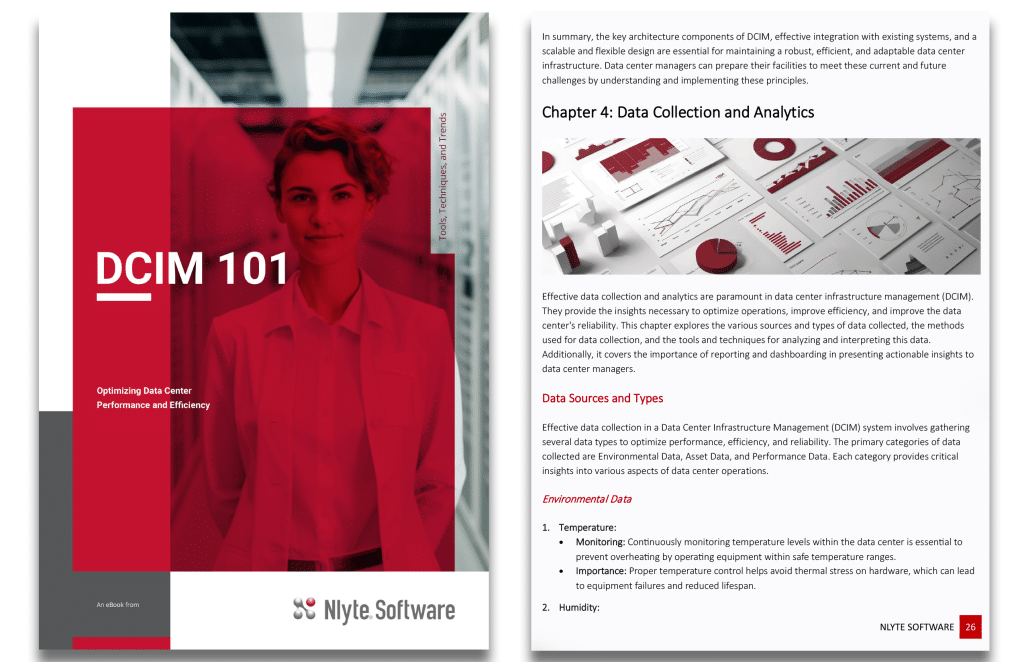Home » Blog » Data Center » DCIM » DCIM 101: Navigating the Backbone of Modern Data Center Management
DCIM 101: Navigating the Backbone of Modern Data Center Management
Published on February 29, 2024,
by Michael Wilson
DCIM basics for data centers are essential for managing today’s complex IT environments with greater efficiency and control. As data centers evolve to support growing digital demands, Data Center Infrastructure Management (DCIM) provides the tools to monitor, automate, and optimize operations. From real-time visibility to streamlined workflows, DCIM is the foundation of modern infrastructure strategy.
The Essence of DCIM
At its core, DCIM transcends traditional management tools like spreadsheets, CAD, and makeshift databases, offering a solution that combines real-time monitoring, proactive alarms, and enterprise-class architecture. This innovative approach automates labor-intensive activities such as workflow management and enhances visibility across IT, Building Management Systems (BMSs), and business systems. The result? Unprecedented efficiency and utilization within data centers ensure that operations run smoothly and that infrastructure planning and design are optimized.
Components of a Robust DCIM Strategy
Infrastructure & Operations (I&O) teams need a robust suite of tools and solutions that DCIM provides to navigate today's complex data center environments. These are designed to manage components across BMSs, on-premises data centers, IT service management (ITSM), clouds, and financial systems, ensuring cohesive operation across various platforms and locations.
- Asset Life-Cycle Management: This aspect of DCIM provides in-depth insights into assets and their environment, enhancing visibility and management through robust dashboards and reporting. Every phase of an asset's life cycle is meticulously managed, from provisioning to decommissioning.
- Automated Workflow and Change Management: By coordinating activities across departmental resources, DCIM ensures that change management requests are addressed efficiently, bridging communication gaps between facilities and IT departments.
- Bidirectional Systems Integration: This component automates changes on the data center floor, offering end-to-end visibility of time and costs and enabling accurate mapping of virtual to physical dependencies.
- Audit and Reporting: Through automated reporting, DCIM significantly reduces the manual effort involved in auditing, ensuring configurations are executed as requested and instantly highlighting key performance indicators (KPIs) and discrepancies.
- Capacity Planning: DCIM allows for a visual representation of various resources, enabling proactive management and accurate predictions of data center lifespans.
- Compliance Reporting: With global awareness of sustainability and regulatory requirements on the rise, DCIM aids in navigating the complex landscape of compliance, ensuring data accuracy and adherence to standards.
- Facilities Insight, Power Management, and Workload Insight: These components of DCIM provide a holistic view of the data center's operations, from power management to workload distribution, ensuring optimal performance and efficiency.
- Real-time Data Collection: Leveraging AI and machine learning, DCIM integrates real-time analytics to track and report on critical metrics, helping avert potential bottlenecks and ensuring global visibility of operations.
The Future of DCIM
As data centers continue to evolve and expand, the role of DCIM will only grow in importance. With its ability to streamline operations, enhance efficiency, and ensure compliance, DCIM is a pivotal component in the management of modern data centers. For businesses looking to thrive in the digital age, embracing DCIM is not just an option; it's a necessity.
DCIM represents the convergence of technology and management practices, providing a strategic framework that ensures data centers can meet today's and tomorrow's demands. With DCIM, businesses can look forward to a future where data center operations are managed and optimized for efficiency, sustainability, and growth.
 |
Like to learn more about DCIM?Download our free eBook DCIM 101 Unlock the secrets to efficient data center management with our free DCIM 101 eBook from Nlyte Software. Discover comprehensive insights on asset management, capacity planning, environmental monitoring, and more. Download now to enhance your data center operations and stay ahead in the evolving technological landscape! |
See Nlyte in Action
Featured Posts
Achieving Edge Data Center Uptime with Resiliency
Achieving Edge Data Center Uptime with Resiliency As edge computing becomes a cornerstone of digital infrastructure, ensuring high availability across a distributed network of edge data centers is more critical than ever. These facilities often…
The DCIM Payback: Justifying Your Investment
Data Center Infrastructure Management (DCIM) software bridges the gap between IT and facilities, transforming data centers from cost centers into optimized, value-generating assets. While the initial investment is a key consideration, the returns generated through…
Expanding your Data Center is Simplified with Nlyte Software
Are there plans within your organization to expand its data center without any foresight into how to overcome the inevitable challenges? Is the Senior Leadership team asking how the data center expansion will impact the business? Fortunately, Nlyte Software has a robust Data Center Infrastructure Management (DCIM) tool, implemented by customers globally, across all verticals to help them successfully expand their data center, without unnecessary obstacles.
Reducing Data Centers' Carbon Footprint: Strategies and Tools for Sustainability
The world is facing a climate crisis, and every sector has a role in reducing carbon emissions. Data centers, the backbone of the digital age, are significant contributors to carbon emissions. The good news is…

